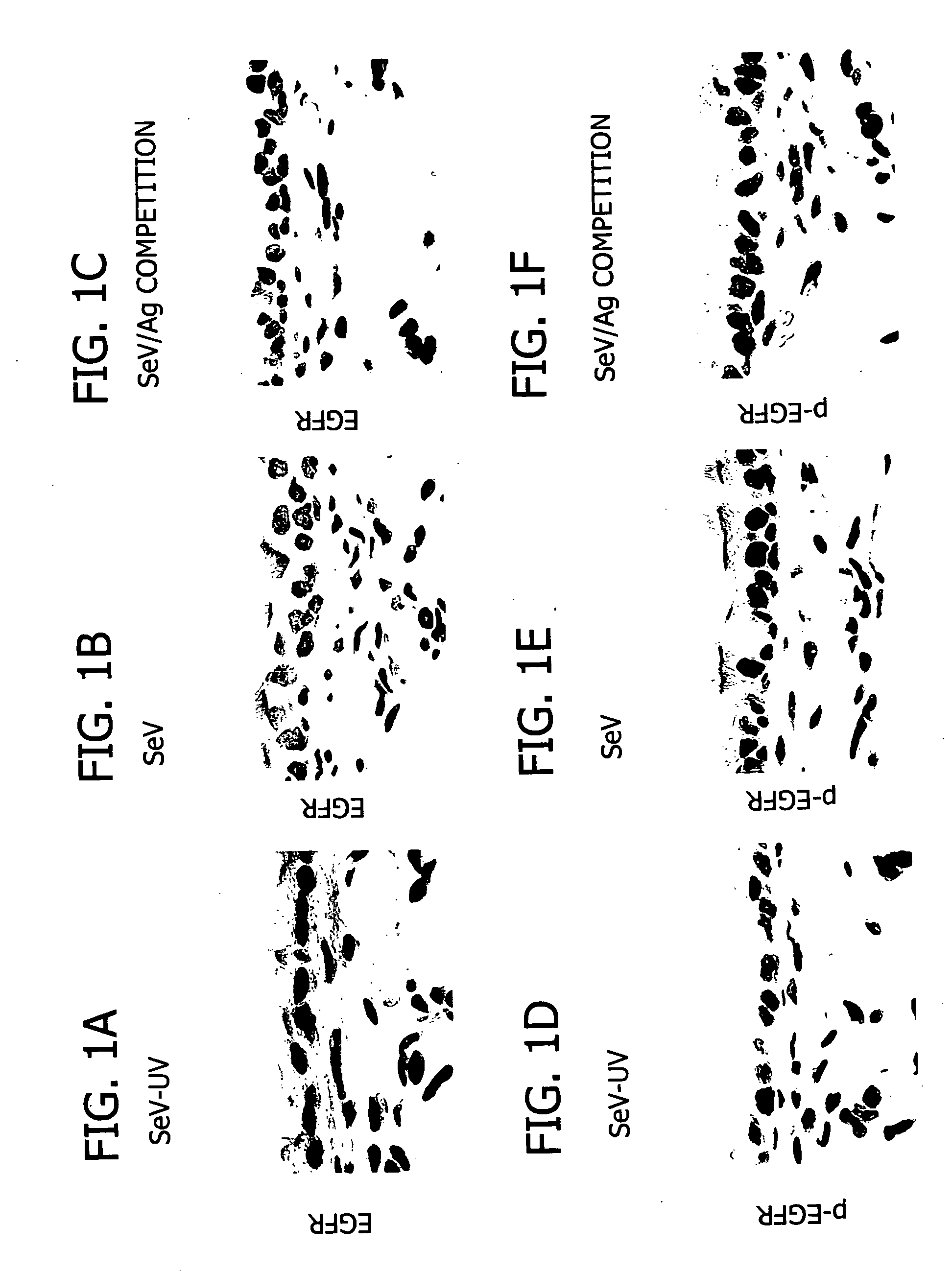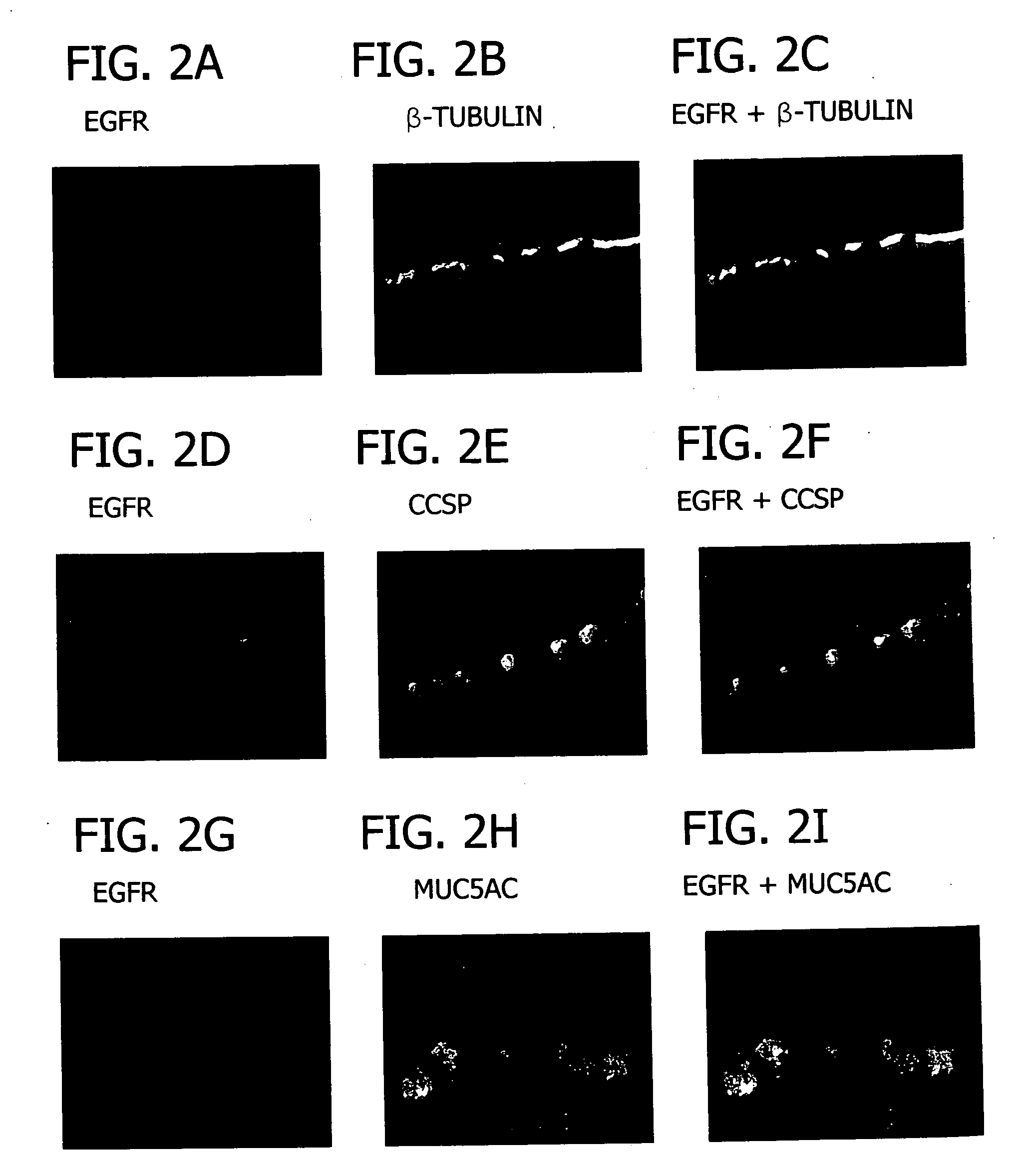Compositions and methods for treatment of airway hypersecretion
a technology applied in the field of compositions and methods for the treatment of airway diseases, can solve the problems of airway obstruction, small airway, peripheral airway, which cannot be cleared by coughing, and is particularly vulnerable to mucus accumulation, so as to improve the treatment of airway hypersecretion
- Summary
- Abstract
- Description
- Claims
- Application Information
AI Technical Summary
Benefits of technology
Problems solved by technology
Method used
Image
Examples
example 1
Persistent Activation of EGFR on Ciliated Epithelial Cells
[0107] EGFR behavior in mouse airway epithelium was assessed in mice inoculated with mouse parainfluenza virus (Sendai virus; SeV), as common human paramyxoviruses (e.g., respiratory syncitial virus or metapneumovirus) generally replicate poorly in mice. In this model system, inoculation results in replication with high efficiency in the bronchiolar mucosa with consequent induction of immune-response gene expression, immune cell infiltration, and damage of the epithelium (Walter et al. (2001) J. Exp. Med. 193, 339-352). This host response allows for complete clearance of SeV by 10-12 days after inoculation. (Walter, et al. (2002). J. Clin. Invest. 110:165-175; Tyner, et al. (2005) Nat. Med. 11:1180-1187) The injury is followed by epithelial repair and restoration of normal airway architecture in some mouse strains, but can be followed by long-term (likely permanent) goblet cell metaplasia in C57BU6J mice that appears about 2...
example 2
Functional Role of EGFR Signaling on Ciliated Epithelial Cells
[0115] To define a functional role for persistent EGFR signaling on ciliated epithelial cells, lung sections were subjected to immunostaining with markers for ciliated epithelial cells, Clara cells, and goblet cells. Tissue preparation and immunostaining were as described above.
[0116] Quantitative analysis of cell types found in the airway epithelium indicated that SeV-infected mice developed increases in ciliated and goblet cells and concomitant decreases in Clara cells at day 21 (but not by day 12) after inoculation compared to control mice inoculated with SeV-UV (FIGS. 3-4). It was next determined whether EGFR signaling is necessary for these observed changes in epithelial architecture. Using an orally administered, irreversible EGFR inhibitor, EKB-569, to treat mice daily from postinfection day 10 through 21, full inhibition of Akt activation was achieved in whole mouse lung at day 21 post-infection (FIG. 30), indic...
example 3
EGFR Signaling and Ciliated Cell Survival in Culture
[0119] To determine whether EGFR provides necessary survival signals to ciliated epithelial cells, EGFR blockade was analyzed in tissue culture where macrophage clearance would not obscure detection of apoptotic cells and where signaling events could be better defined. Initial experiments aimed to determine whether EGFR was localized to ciliated epithelial cells in culture as was found in vivo. The epithelial system was reconstituted in vitro using air-liquid interface cultures of airway epithelial cells harvested from mouse trachea. In this system, ciliated β-tubulin positive) cells represented 45±1% of the total cell population, a level that was similar to normal mouse airways (36% for large-sized airways) and to values for mouse tracheal specimens reported previously (Pack et al. (1980) Cell Tissue Res. 208, 65-84). As was the case in vivo, the ciliated epithelial cells in culture exhibited constitutive expression of EGFR and p...
PUM
| Property | Measurement | Unit |
|---|---|---|
| Mass | aaaaa | aaaaa |
| Mass | aaaaa | aaaaa |
| Mass | aaaaa | aaaaa |
Abstract
Description
Claims
Application Information
 Login to View More
Login to View More - R&D
- Intellectual Property
- Life Sciences
- Materials
- Tech Scout
- Unparalleled Data Quality
- Higher Quality Content
- 60% Fewer Hallucinations
Browse by: Latest US Patents, China's latest patents, Technical Efficacy Thesaurus, Application Domain, Technology Topic, Popular Technical Reports.
© 2025 PatSnap. All rights reserved.Legal|Privacy policy|Modern Slavery Act Transparency Statement|Sitemap|About US| Contact US: help@patsnap.com



